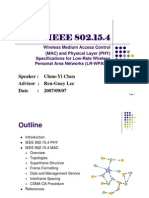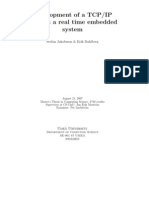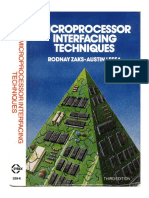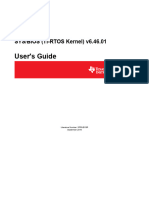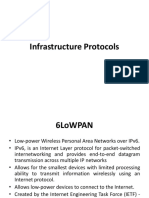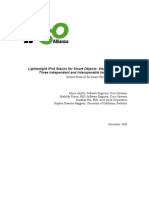6LoWPAN Protocol Stack
Uploaded by
Nikhil PS6LoWPAN Protocol Stack
Uploaded by
Nikhil PSJournal of Theoretical and Applied Information Technology
31st July 2012. Vol. 41 No.2
2005 - 2012 JATIT & LLS. All rights reserved.
ISSN: 1992-8645
www.jatit.org
E-ISSN: 1817-3195
A STUDY ON PROTOCOL STACK IN 6LOWPAN MODEL
1
NURUL HALIMATUL ASMAK ISMAIL, 2ROSILAH HASSAN, 3KHADIJAH W. M. GHAZALI
1, 2, 3
Network & Communication Technology Lab, Software Technology and Management Unit,
Faculty of Information Science and Technology,
Universiti Kebangsaan Malaysia, 43600, UKM Bangi, Selangor Darul Ehsan, Malaysia.
E-mail: 1anas_albakhri@yahoo.com , 2rosilah@ftsm.ukm.my , 3khadijah@utem.edu.my
ABSTRACT
Due to recent advances of heterogeneous network and the emergence of Internet of Things (IoT), wireless
personal area networks including wireless sensor networks are assumed to be part of the huge
heterogeneous network. This calls for a smooth integration between the higher network layer protocols
Internet Protocol version 6 (IPv6) and the lower media access control (MAC) layer protocol IEEE 802.15.4.
IEEE 802.15.4 is a standard that specifies the physical layer and MAC layer for Wireless Personal Area
Network (WPAN). This standard is suited for Low-Rate Wireless Personal Area Networks (LR-WPANs), a
constrained network of tiny, low power, low rate, small size memory with low computation and
communication capabilities. However, IPv6 is forming the backbone of the desired heterogeneous network.
Direct integration between IPv6 and IEEE 802.15.4 lower network layers is not possible. Hence, latest
technology development is the transmission of IPv6 packets over Low-power Wireless Personal Area
Networks (6LoWPAN). This has enforced some modification to the existing protocol stack and introduced
the 6LoWPAN protocol stack. The 6LoWPAN protocol stack involves 802.15.4 physical (PHY) and
Medium Access Control (MAC) layer, 6LoWPAN adaptation layer, network layer, transport layer and
application layer with specific 6LoWPAN application. This review paper describes all layers in 6LoWPAN
protocol stack including its routing protocols, namely the Route-over and Mesh-under. These routing
schemes are applied in 6LoWPAN adaptation layer and network layer.
Keywords: 6lowpan, Protocol Stack, Adaptation Layer, MAC, PHY
1. INTRODUCTION
Sensor node is the emergence of new
technologies is a small, low-power, low-cost and
multifunctional devices. These tiny devices are
capable of sensing, computation (signal processing)
and wireless communication capabilities. In some
applications, these sensors can be mobile. Mobility
issues have been discussed in [1]. Collaboration
between the sensor nodes is capable of producing
powerful wireless networking systems known as
Wireless Sensor Nodes. However, the use of
Internet Protocol (IP) in these networks has
embarked on the development of Internet Protocol
version 6 (IPv6) over Low power Wireless Personal
Area Networks (6LoWPAN). 6LoWPAN defines
that layering of IPv6 over low-power, low
bandwidth, low-cost and small network by IEEE
802.15.4 standard. There are many main issues
related to 6LoWPAN, including the IP connectivity,
topologies,
limited
packet
size,
limited
configuration and management, service and security
discovery [2].
Basically, 6LoWPAN protocol stack are
comprises of 802.15.4 physical (PHY) and medium
access control (MAC) layer, adaptation layer,
network layer, transport layer and application layer.
Now days, many research on these layers have been
made and analyze. 802.15.4 PHY and MAC are
exactly similar to ZigBee protocol standard. In this
paper, review of protocol stacks in 6LoWPAN is
identified and some routing protocols are involved.
There have been a few developments on routing
protocols for 6LoWPAN and it can be categorized
into two routing schemes: Route-over and Meshunder. Some protocols for mesh-under are
described as below. The 6LoWPAN Ad-Hoc OnDemand Distance Vector Routing protocol (LOAD)
has been proposed in [4]. LOAD is a simplifies
routing protocol based on Ad hoc On-Demand
Distance Vector (AODV) for 6LoWPAN. This
routing protocol is a single path routing protocol. It
enables multi-hop routing between IEEE 802.15.4
devices to establish and maintain routing routes in
6LoWPAN.
Besides that, Dynamic MANET On-demand for
6LoWPAN Routing (DYMO-low) [5] is another
220
Journal of Theoretical and Applied Information Technology
31st July 2012. Vol. 41 No.2
2005 - 2012 JATIT & LLS. All rights reserved.
ISSN: 1992-8645
www.jatit.org
6LoWPAN routing protocol that based on Dynamic
MANET On-demand (DYMO). DYMO-low
positioning is underneath of IP layering in creating
a mesh network topology of IEEE 802.15.4 devices.
It use single wireless interface underneath and
unbeknownst to IP. The significant feature in
DYMO-low is it can support either 16-bit link layer
short address or IEEE 64-bit extended address
(EUI-64).
On the other hand, considering low power, low
memory, low bandwidth and small packet size of
the 6LoWPAN devices, the on-demand multi-hop
routing with routing table and EUI-64 identifier
may limit the scalability. Hierarchical Routing for
6LoWPAN (HiLow) is employed in 6LoWPAN
because of the capability of the dynamic assignment
of 16-bit short addresses [6]. Extensively, it reduces
the overhead of maintaining routing tables and
support larger scalability.
Expectation (ALE) working group would occur
between 2005 and 2011 [12]. Since, IPv4 defines a
32 bit address is meant that, there are 2^32 (4 294
967 296) unique address available. However, most
of the addresses are already occupied and the
Internet is simply running out of IPs. Then, IPv6 is
developed based on experience of developing IPv4.
It is designed to handle the growth rate of the
Internet [13]. There are a few advantages of IPv6
over IPv4 that can be highlighted in table 1.
2.2 IEEE 802.15.4
IEEE 802.15.4 is a standard that specifies the
physical (PHY) layer and media access control
(MAC) layer for smallest devices in wireless
personal area network. The characters and its
description of IEEE 802.15.4 standard are listed
below [11]:
2. 6LoWPAN OVERVIEW
6LoWPAN is an abbreviation of IPv6 over Low
Power Wireless Area Networks. The specification
of 6LoWPAN involves the transmission of IPv6
over IEEE 802.15.4 network. The original idea is
that the Internet Protocol can be applied to the tiny
and lightweight devices [3]. Figure 1 shows
6LoWPAN position in the network hierarchy. A
wireless personal area network (WPAN) is types of
wireless networking. It is a network for
interconnecting devices around specific workspace
where the connections are wireless. Network layer
addressing scheme can be categorized into, the
fourth and sixth revisions in the development of the
Internet Protocol (IP), IPv4 and IPv6 respectively.
Since the futuristic IPv6 protocol was created to
supersede and replace IPv4, in conjunction with the
revolution of heterogeneous network and internet of
things, 6LoWPAN came to life avoiding creation of
unborn 4LoWPAN protocol.
The main difference between 6LoWPAN and
OSI protocol stacks is the emergence of adaptation
layer. This layer is assumed to perform
fragmentation/reassembly, header compression and
mesh addressing which will be addressed later in
this paper.
2.1 IPv4 and IPv6
IPv6 known as Internet Protocol version 6
designed through an operation by transferring data
in small packets that are independently routed
across networks as specified by international
communications protocol. The exhaustion of IPv4
address as predicted by the Address Lifetime
E-ISSN: 1817-3195
Low bandwidth specifies the difference data
rates of 250 kbps, 40 kbps, and 20 kbps for each
defined physical layers 2.4 GHz, 915 MHz and
868 MHz.
Low power specifies that some or all devices
are battery operated.
Low cost specifies that these devices
collaborating with sensors which adopt low
processing capabilities and low memory usage.
Distance covered from the range of 10 m to 100
m, typically it is in small room, small area of
specific location.
Devices involved are the Full Function Device
(FFD) and Reduced Function Device (RFD).
FFD will act as a coordinator and router. The
coordinator will form networks and route
packets, the router will routes packet. RFD is
the end device which will act as a sensor and
used to be sleep mode.
Two types of modes involved by MAC layer are
beacon enabled and non-beacon modes [11].
With this, the IETF working group insinuating IPv6
over low rate, low power, low cost which adopt
physical layer and MAC layer of IEEE 802.15.4
standard. Figure 2 shows the architecture of a
device in accordance with the IEEE 802.15.4
standard and has the characteristics of low power,
low memory usage and low cost. Transmission of
data packets by a RFD or a low power processing
in sensor nodes to outside 6LowPAN will be
forwarded through FFD. The FFD will act as a
router in 6LowPAN and forward the data to the
gateway of 6LowPAN. Gateway of 6LowPAN that
connects with IPv6 domain will forward data
packets to the receivers devices using IP address
[3].
221
Journal of Theoretical and Applied Information Technology
31st July 2012. Vol. 41 No.2
2005 - 2012 JATIT & LLS. All rights reserved.
ISSN: 1992-8645
www.jatit.org
Figure 1. 6LoWPAN in networking
Figure 2. 6LoWPAN overview
222
E-ISSN: 1817-3195
Journal of Theoretical and Applied Information Technology
31st July 2012. Vol. 41 No.2
2005 - 2012 JATIT & LLS. All rights reserved.
ISSN: 1992-8645
www.jatit.org
E-ISSN: 1817-3195
Table 1. Comparisons of IPv6 and IPv4 based on main features[14]
Address Space
Routing
(packet fragmentation)
Mobility
Quality of Services
Security
Auto Configuration of
Hosts
Checksum in header
Header includes options
Fragmentation
IP configuration
IPSec support
Unicast, multicast and
broadcast
Address Resolution
Protocol (ARP)
IPv4
232 address space
End station and
routers
Need agent & used
MIPv4
High latency &
differentiated
services
Site-to-site secure
communications
Need configuration
Included
Required
Use to resolve an
IPv4 address
6LoWPAN stack layers consist of PHY layer,
MAC layer, adaptation layer, network layer,
transport layer and application layer. Basically, it
employs how the IEEE 802.15.4 devices to
communicate with each other over a wireless
channel.
3.1 6LoWPAN Physical Layer
The 6LoWPAN PHY layer provides two
services: the PHY data service and the PHY
No agent &
used MIPv6
Low latency & Use
traffic classes & flow
labels
End-to-end secure
communications
Plug-and-play
Faster handover
Auto-configuration or
DHCP
Required
Uses unicast,
multicast and anycast
Replaced by neighbor
Discovery
Optional
Use all
6LOWPAN STACK LAYERS
IPv6 Advantages
More address space
Faster routing
No checksum
Moved to IPv6
extension headers
Source node
Routers & source
node
Manually or DHCP
Figure 3a. and 3b. explain the differences of the
OSI Layer Model and the reference model of
6LoWPAN protocol stack. It adopts IEEE 802.15.4
standard PHY and MAC layers which are specified
in [3]. 6LoWPAN Model consists of application
layer, presentation layer, session layer, transport
layer, network layer, IEEE 802.15.4 MAC layer
and IEEE 802.15.4 PHY layer. This paper will
address all layers in 6LoWPAN. However, the main
idea is to emphasis the network layer and
adaptation as it is the main framework of
6LoWPAN.
IPv6
2128 address space
End station
Enhanced support
More secure
Faster configuration
Faster routing
Faster routing
Faster routing
Speed up connection
Better security
Less packet traffic
Less packet traffic
management service interfacing to the physical
layer management entity (PLME) service access
point (SAP) known as the PLME-SAP [8].
The PHY data services ultimately provides
transmission and reception of data packets between
MAC and PHY across the physical radio channel,
as well as the PHY management service interface,
which offers access to every layer management
function and maintains a database of information on
related personal area networks. It is based on IEEE
802.15.4 with data rate of 250 kbps and operates at
frequency of 2400 2483.5 MHz. Figure 4 shows
the PHY layer protocol data unit of IEEE 802.15.4
is compliant with a maximum payload of 127 bytes.
The PHY is prefixed prefixed by a
Synchronization Header (SHR) fields encompasses
the Preamble Sequence and Start of Frame
Delimiter fields, and a PHY Header (PHR)
encompasses of Frame Length/Reserved. The SHR
condone the receiver to achieve symbol
synchronization. As a result, the SHR, PHR, and
PHY payload form PHY packet.
223
Journal of Theoretical and Applied Information Technology
31st July 2012. Vol. 41 No.2
2005 - 2012 JATIT & LLS. All rights reserved.
ISSN: 1992-8645
www.jatit.org
Figure 3a. OSI layer model
Figure 3b. Comparison of 6LoWPAN layer model and OSI layer model
Figure 4. IEEE 802.15.4 PHY Packet Structure
224
E-ISSN: 1817-3195
Journal of Theoretical and Applied Information Technology
31st July 2012. Vol. 41 No.2
2005 - 2012 JATIT & LLS. All rights reserved.
ISSN: 1992-8645
www.jatit.org
3.2 6LoWPAN Data Link Layer
The 6LoWPAN Data Link Layer, which is the
MAC sub-layer, provides two services: the MAC
data service and the MAC management service
interfacing to the MAC sub-layer management
entity (MLME) service access point (SAP)
(MLMESAP). The MAC data service is to let the
transmission and receiving of MAC protocol data
units (MPDU) across the PHY data service. In
IEEE 802.15.4 standard defined 4 frame structures
for MAC layer: data frame, beacon frame,
acknowledgement frame and MAC command
frame.
Basically, MAC data frame is used for data
transferring, MAC beacon frame is generated by
coordinator for synchronization, MAC command
frame is used by MAC management entity and
MAC acknowledgement frame will acknowledge
successful reception of the frame. Figure 5 explain
the general MAC frame format.
E-ISSN: 1817-3195
adaptation layer should handle these fragmentation
and reassembly process.
Header Compression
IEEE 802.15.4 defines four types of frames:
beacon frames, MAC command frames,
acknowledgement frames, and data frames [7].
Figure 7 shows IPv6 packets must be carried on
data frames. After the packet is fragmented and
transmitted over IEEE 802.15.4 frames, each
fragment carries a part of the original IPv6 packets.
The IEEE 802.15.4 frame which has a maximum
packet size of 128 bytes; instead IPv6 header size is
40 bytes, User Datagram Protocol (UDP) and
Internet Control Message Protocol (ICMP) header
sizes are both 4 bytes, fragmentation header add
another 5 bytes overhead. Without compression,
802.15.4 is not possible to transmit any payload
effectively.
Routing
Figure 5 shows MAC Header (MHR) has frame
control, sequence number and address information
fields. The addressing field contains source and
destination of PAN and its address. The
information of IPv6 is allocated in the payload
which is the MAC service data unit (MSDU). Then,
the MFR has Frame Check Sequence (FCS). The
MHR, MSDU and MFR form the general MAC
frame format.
There are a number of existing routing protocols
in 6LoWPAN like: 6LoWPAN Ad-hoc On-Demand
Distance Vector (LOAD), Multipath based
6LoWPAN Ad-hoc On-Demand Distance Vector
(MLOAD), Dynamic MANET On-Demand for
6LoWPAN Routing (DYMO-Low), Hierarchical
Routing (Hi-Low), Extended Hi-Low and Sink Adhoc On-Demand Distance Vector Routing (SAODV).
3.3 6LoWPAN Adaptation Layer
3.4 6LoWPAN Network Layer
The 6LoWPAN format delineate on IPv6
communication is carried in 802.15.4 frames and
specifies the adaptation layers key elements.
6LoWPAN has three primary elements:
The 6LoWPAN network layer provides the
internetworking capability to sensor nodes. The
main considerations of this layer are addressing,
mapping and routing protocols. As described
earlier, mesh-under routing decision occurs in
6LoWPAN adaptation layer. On the other hand,
route-over routing decision occurs in 6LoWPAN
network layer.
Fragmentation and Reassembly
IPv6 packet size over IEEE 802.15.4 is 1280
bytes [7]. However, the packet size is larger than
IEEE 802.15.4 frame. In this condition, IPv6 packet
size unable to be encapsulated in one IEEE
802.15.4 frame. 802.15.4 protocol data units have
variety of sizes. It depends on the overhead
occurred [8]. Maximum Transmission Unit (MTU)
for IEEE 802.15.4 is 127 bytes. This frame has 25
bytes, header, footer and addressing, overheads. In
addition, security header imposed by Link Layer
adds 21 bytes overhead when AES-CCM-128 is
used. As a result, the remaining for payload is 81
bytes as shown in figure 6a and 6b.
Due to this matter, one IPv6 that need to be
transmitted over IEEE 802.15.4 frame has to be
divided to more than 16 fragments. Hence,
Figure 8 shows routing decision layer for both
mesh-under and route-over routing protocols. The
main differences of routing issues in route-over and
mesh-under schemes are in packet/fragment
forwarding process rather than route establishment
phase. In route-over scheme, each link layer hop is
an IP hop and each node acts as IP router. The
packet is forwarded hop by hop from source to
destination between these links. The packets
payload is encapsulated in IP header.
Later, IP packet is fragmented and the fragments
are sent to the next hop based on routing table
information. If the adaptation layer in the next hop
received all the fragments successfully, then it
225
Journal of Theoretical and Applied Information Technology
31st July 2012. Vol. 41 No.2
2005 - 2012 JATIT & LLS. All rights reserved.
ISSN: 1992-8645
www.jatit.org
Figure 5.General MAC frame format
Figure 6a. IEEE 802.15.4 frame format
Figure 6b. IEEE 802.15.4 frame format
226
E-ISSN: 1817-3195
Journal of Theoretical and Applied Information Technology
31st July 2012. Vol. 41 No.2
2005 - 2012 JATIT & LLS. All rights reserved.
ISSN: 1992-8645
www.jatit.org
E-ISSN: 1817-3195
Figure 7. IEEE 802.15.4 frame format
Figure 8. Routing decision layer
creates an IP packet from fragments and sends it up
to the network layer. After that, the network layer
sends the packet to the upper layer (transport layer),
if the packet is destined for it. Otherwise, it
forwards the packet to the next hop according to the
routing table information. However, if there are
some fragments missing, all fragments are
retransmitted to one hop distance.
3.5 6LoWPAN Transport Layer
Similar to the transport layer in OSI model,
6LoWPAN transport layer is responsible for
process-to-process delivery.
It delivers data
segment to the appropriate application process on
the host computers. In this layer, there are two
types of transport protocols; User Datagram
Protocol (UDP) and Transmission Control Protocol
(TCP). At the source side, either TCP or UDP
connections is established based on the application.
Hence, either TCP or UDP processes is created.
The data from application layer is organized in
either UDP or TCP segments and attached to
created process (TCP or UDP processes). At the
destination side, after the UDP or TCP segments is
received from the network layer, the transport layer
processes the segment probably based on the
protocol used and send it up to the application
layer. However, the most common protocol applied
with 6LoWPAN is the UDP [10]. In aspect of
performance, efficiency and complexity, TCP is not
preferably used with 6LoWPAN.
227
Journal of Theoretical and Applied Information Technology
31st July 2012. Vol. 41 No.2
2005 - 2012 JATIT & LLS. All rights reserved.
ISSN: 1992-8645
www.jatit.org
3.6 6LoWPAN Application Layer
The 6LoWPAN application layer uses a socket
interface for a specific application. From figure 9
below, each 6LoWPAN application opens a socket
which is then used to receive or send packets. Each
socket is associated with a protocol, TCP or UDP,
and source and/or destination ports [9].
Figure 9. 6LoWPAN application uses a socket
interface for a specific application
CONCLUSIONS
This paper describes the emergence of
6LoWPAN due to heterogeneous network. We have
reviewed the 6LoWPAN, integration between
higher network layer protocol of IPv6 and lower
MAC layer protocol of IEEE 802.15.4. Hence, it
enforces some modification in the existing protocol
stack and introduce 6LoWPAN protocol stack.
Moreover, some comparisons between IPv4 and
IPv6 have been made and reviewed. Besides that,
two routing scheme was identified: Route-over and
Mesh-under and these schemes are applied in
6LoWPAN adaptation layer and network layer.
REFERENCES:
[1] Samer A. B. Awwad, Ng Chee Kyun, Nor
Kamariah Noordin, Mohd Fadlee A. Rasid, A.
R. H. Alhawari: Mobility and Traffic Adapted
Cluster Based Routing for Mobile Nodes
(CBR-Mobile) Protocol in Wireless Sensor
Networks. ADHOCNETS 2010: 281-296
[2] G.K. Ee, C.K. Ng, N.K. Noordin, and B.M. Ali,
A Review of 6LoWPAN Routing Protocols,
In Proceeding(s) of the Asia Pacific Advanced
Network.
E-ISSN: 1817-3195
[3] C.S. Kushalnagar, N.G. Montenegro, IPv6
over Low-Power Wireless Personal Area
Networks
(6LoWPANs):
Overview,
Assumptions, Problem Statement, and Goals,
2007, pp. 1-13.
[4] Kim, K.; Daniel Park, S.; Montenegro, G.; Yoo,
S.; Kushalnagar, N. 6LoWPAN Ad Hoc OnDemand Distance Vector Routing (LOAD),
draft-daniel-6lowpan-load-adhoc-routing-03,
2007.
[5] Kim, K.; Park, S.; Chakeres, I.; Perkins, C.
Dynamic MANET On-demand for 6LoWPAN
(DYMO-low) Routing, draft- montenegro6lowpan-dymo-low-routing-03, 2007.
[6] Kim, K.; Yoo, S.; Park, J.; Daniel Park, S.; Lee,
J. Hierarchical Routing over 6LoWPAN
(HiLow),
draft-deniel-6lowpanhilowhierarchical-routing-00.txt, 2005.
[7] A.H. Chowdhury, M. Ikram, H.-S. Cha, H.
Redwan, S.M.S. Shams, K.-H. Kim, and S.-W.
Yoo, Route-over vs mesh-under routing in
6LoWPAN, Proceedings of the 2009
International
Conference
on
Wireless
Communications and Mobile Computing
Connecting the World Wirelessly - IWCMC
09, 2009, p. 1208.
[8] C.S.
Kushalnagar,
N.G.
Montenegro,
Transmission of IPv6 Packets over IEEE
802.15.4 Networks, 2007, pp. 1-31.
[9] 802.15.4-2003, IEEE standard, Wireless
medium access control and physical layer
specifications for low-rate wireless personal
area networks, 2003.
[10] J. Postel, User Datagram Protocol, IEN-88,
USC/Information Sciences Institute, May 1979,
pp. 1-4.
[11] J. Misic, V.B. Misic, and S. Shafi,
Performance of IEEE 802.15.4 beacon enabled
PAN with uplink transmissions in nonsaturation mode - access delay for finite
buffers, First International Conference on
Broadband Networks, pp. 416-425.
[12] X. Ma and W. Luo, The Analysis of
6LowPAN Technology, 2008 IEEE PacificAsia Workshop on Computational Intelligence
and Industrial Application, Dec. 2008, pp. 963966.
[13] M. Boucadair, J.-L. Grimault, P. Lvis, a
Villefranque, and P. Morand, Anticipate IPv4
Address Exhaustion: A Critical Challenge for
Internet Survival, 2009 First International
Conference on Evolving Internet, Aug. 2009,
pp. 27-32.
228
Journal of Theoretical and Applied Information Technology
31st July 2012. Vol. 41 No.2
2005 - 2012 JATIT & LLS. All rights reserved.
ISSN: 1992-8645
www.jatit.org
[14] Rosilah Hassan and M. Khairil Sailan, 2011.
End-to-End Baseline File Transfer Performance
Testbed. Information Technology Journal, 10:
446-451. T.S. Bhatti, R.C. Bansal, and D.P.
Kothari, Reactive Power Control of Isolated
Hybrid Power Systems, Proceedings of
International
Conference
on
Computer
Application in Electrical Engineering Recent
Advances (CERA), Indian Institute of
Technology Roorkee (India), February 21-23,
2002, pp. 626-632.
229
E-ISSN: 1817-3195
You might also like
- What Men Dont Want Women To Know - The Secrets, The Lies, The Unspoken Truth - Smith and Doe90% (20)What Men Dont Want Women To Know - The Secrets, The Lies, The Unspoken Truth - Smith and Doe157 pages
- 7839+ Awesome Deep Web Onion Links List (Uncensored Content) PDF74% (35)7839+ Awesome Deep Web Onion Links List (Uncensored Content) PDF391 pages
- Darknet-Bible - Everything You Need To Know To Order Safely at Darknet Markets100% (3)Darknet-Bible - Everything You Need To Know To Order Safely at Darknet Markets218 pages
- Organizing Solutions For People With ADHD, 2nd Edition-Revised and Updated95% (58)Organizing Solutions For People With ADHD, 2nd Edition-Revised and Updated221 pages
- Sunbeam Popcorn Maker FPSBPP7310 FPSBPP731660% (10)Sunbeam Popcorn Maker FPSBPP7310 FPSBPP73169 pages
- 30 Best Tor Sites For Any and Everything You'll Ever Need! - Your Hacker89% (28)30 Best Tor Sites For Any and Everything You'll Ever Need! - Your Hacker8 pages
- Batra N., Goyal S. IoT Fundamentals With A Practical Approach 2025No ratings yetBatra N., Goyal S. IoT Fundamentals With A Practical Approach 2025289 pages
- Side Hustle Bible (James Altucher) (Z-Library)100% (3)Side Hustle Bible (James Altucher) (Z-Library)197 pages
- How To Find Out Anything About A Person - The Best Tutorial You Can Find100% (3)How To Find Out Anything About A Person - The Best Tutorial You Can Find37 pages
- The Art of Invisibility - The World's Most Famous Hacker Teaches You How To Be Safe in The Age of Big Brother and Big Data - PDF Room100% (2)The Art of Invisibility - The World's Most Famous Hacker Teaches You How To Be Safe in The Age of Big Brother and Big Data - PDF Room252 pages
- Lora-Based Mesh Network For Iot Applications: Heon Huh Jeong Yeol KimNo ratings yetLora-Based Mesh Network For Iot Applications: Heon Huh Jeong Yeol Kim4 pages
- Internal Shift Report w21-2020 Ip SPM v2 0No ratings yetInternal Shift Report w21-2020 Ip SPM v2 0689 pages
- Slides 97 Lpwan 35 Wi Sun Presentation 00No ratings yetSlides 97 Lpwan 35 Wi Sun Presentation 0014 pages
- BIOS and Kernel Developer's Guide (BKDG) For AMD Family 16h Models 00h-0Fh Processors100% (1)BIOS and Kernel Developer's Guide (BKDG) For AMD Family 16h Models 00h-0Fh Processors921 pages
- Direct Drive DC Torque Motors Catalog 2005No ratings yetDirect Drive DC Torque Motors Catalog 200512 pages
- Zaks - Microprocessor - Interfacing - Techniques100% (1)Zaks - Microprocessor - Interfacing - Techniques466 pages
- Memory Management in Vxworks and RtlinuxNo ratings yetMemory Management in Vxworks and Rtlinux12 pages
- 3.intertask Communication - Embedded OS PDF67% (3)3.intertask Communication - Embedded OS PDF8 pages
- The Test Access Port and Boundary Scan Architecture - Colin M Maunder and Rodham E Tulloss - Ieee Computer Society Press PDFNo ratings yetThe Test Access Port and Boundary Scan Architecture - Colin M Maunder and Rodham E Tulloss - Ieee Computer Society Press PDF394 pages
- Wireless Networking With IEEE 802.15.4 and 6LoWPANNo ratings yetWireless Networking With IEEE 802.15.4 and 6LoWPAN60 pages
- Topic 10 - Thermal Design Consideration For Surface Mount Layouts PDFNo ratings yetTopic 10 - Thermal Design Consideration For Surface Mount Layouts PDF16 pages
- (Erik G. Larsson, Petre Stoica) Space-Time BlockNo ratings yet(Erik G. Larsson, Petre Stoica) Space-Time Block300 pages
- FM Demodulators in Software-Defined Radio Using FPGAs With RapidNo ratings yetFM Demodulators in Software-Defined Radio Using FPGAs With Rapid67 pages
- Implementation of DDR SDRAM Memory Controller For Embedded SOCNo ratings yetImplementation of DDR SDRAM Memory Controller For Embedded SOC5 pages
- IPerf - IPerf3 and IPerf2 User DocumentationNo ratings yetIPerf - IPerf3 and IPerf2 User Documentation15 pages
- The Linux Concept Journey - V4.0 - July 2024No ratings yetThe Linux Concept Journey - V4.0 - July 202450 pages
- Video and Multimedia Transmissions over Cellular Networks: Analysis, Modelling and Optimization in Live 3G Mobile CommunicationsFrom EverandVideo and Multimedia Transmissions over Cellular Networks: Analysis, Modelling and Optimization in Live 3G Mobile CommunicationsNo ratings yet
- Wireless Reviewof6LoWPANRoutingProtocolsNo ratings yetWireless Reviewof6LoWPANRoutingProtocols11 pages
- COOJA Network Simulator: Exploring The Infinite Possible Ways To Compute The Performance Metrics of IOT Based Smart Devices To Understand The Working of IOT Based Compression & Routing ProtocolsNo ratings yetCOOJA Network Simulator: Exploring The Infinite Possible Ways To Compute The Performance Metrics of IOT Based Smart Devices To Understand The Working of IOT Based Compression & Routing Protocols7 pages
- rfc4919 IPv6 Over Low-Power Wireless Personal Area NetworksNo ratings yetrfc4919 IPv6 Over Low-Power Wireless Personal Area Networks13 pages
- Lightweight Ipv6 Stacks For Smart Objects: The Experience of Three Independent and Interoperable ImplementationsNo ratings yetLightweight Ipv6 Stacks For Smart Objects: The Experience of Three Independent and Interoperable Implementations7 pages
- Side Hustle Bible - Ways To Make Money Without A Job82% (11)Side Hustle Bible - Ways To Make Money Without A Job23 pages
- 10 Useful Websites You Wish You Knew Earlier! 6 (2017)0% (1)10 Useful Websites You Wish You Knew Earlier! 6 (2017)21 pages
- How To Build A Shopify Store The Right Way100% (3)How To Build A Shopify Store The Right Way37 pages
- Manufacturing Execution System (MES) : World of InnovationNo ratings yetManufacturing Execution System (MES) : World of Innovation16 pages
- Malwaredotpy - Linux Basics Pentesting TutorialsNo ratings yetMalwaredotpy - Linux Basics Pentesting Tutorials18 pages
- Exam 156-215.80 Check Point Certified Security Administrator R80 Updated Product Type 165 Q&ANo ratings yetExam 156-215.80 Check Point Certified Security Administrator R80 Updated Product Type 165 Q&A64 pages
- Operational Description: St500 Operation Manual Jwpark 1 of 76 St500 0.4 16-02-05No ratings yetOperational Description: St500 Operation Manual Jwpark 1 of 76 St500 0.4 16-02-0576 pages
- University of Gondar: Multimedia Systems Chapter-OneNo ratings yetUniversity of Gondar: Multimedia Systems Chapter-One31 pages
- Modern Power System in A Digital Utility: Puica NituNo ratings yetModern Power System in A Digital Utility: Puica Nitu8 pages
- Instalación Rápida Tarjeta Madre ASrock G41M-VS3 - MultilenguajeNo ratings yetInstalación Rápida Tarjeta Madre ASrock G41M-VS3 - Multilenguaje120 pages
- BFDX DMR Digital Two Way Radios BF-TD503 Walkie Talkie100% (1)BFDX DMR Digital Two Way Radios BF-TD503 Walkie Talkie7 pages
- Network+ Guide To Networks 6th Edition: Topologies and Ethernet StandardsNo ratings yetNetwork+ Guide To Networks 6th Edition: Topologies and Ethernet Standards66 pages
- 2018 - 002075129400004847452018 - Memo Records Not Getting Assigned To BanNo ratings yet2018 - 002075129400004847452018 - Memo Records Not Getting Assigned To Ban8 pages
- Curriculum Vitae Contact: +91-9409116973 Rajesh C Vishwakarma Career ObjectiveNo ratings yetCurriculum Vitae Contact: +91-9409116973 Rajesh C Vishwakarma Career Objective3 pages
- Cryptosystem Based On Modified Vigenere Cipher Using Encryption TechniqueNo ratings yetCryptosystem Based On Modified Vigenere Cipher Using Encryption Technique4 pages
- What Men Dont Want Women To Know - The Secrets, The Lies, The Unspoken Truth - Smith and DoeWhat Men Dont Want Women To Know - The Secrets, The Lies, The Unspoken Truth - Smith and Doe
- 7839+ Awesome Deep Web Onion Links List (Uncensored Content) PDF7839+ Awesome Deep Web Onion Links List (Uncensored Content) PDF
- Darknet-Bible - Everything You Need To Know To Order Safely at Darknet MarketsDarknet-Bible - Everything You Need To Know To Order Safely at Darknet Markets
- Organizing Solutions For People With ADHD, 2nd Edition-Revised and UpdatedOrganizing Solutions For People With ADHD, 2nd Edition-Revised and Updated
- 30 Best Tor Sites For Any and Everything You'll Ever Need! - Your Hacker30 Best Tor Sites For Any and Everything You'll Ever Need! - Your Hacker
- Batra N., Goyal S. IoT Fundamentals With A Practical Approach 2025Batra N., Goyal S. IoT Fundamentals With A Practical Approach 2025
- How To Find Out Anything About A Person - The Best Tutorial You Can FindHow To Find Out Anything About A Person - The Best Tutorial You Can Find
- The Art of Invisibility - The World's Most Famous Hacker Teaches You How To Be Safe in The Age of Big Brother and Big Data - PDF RoomThe Art of Invisibility - The World's Most Famous Hacker Teaches You How To Be Safe in The Age of Big Brother and Big Data - PDF Room
- Lora-Based Mesh Network For Iot Applications: Heon Huh Jeong Yeol KimLora-Based Mesh Network For Iot Applications: Heon Huh Jeong Yeol Kim
- BIOS and Kernel Developer's Guide (BKDG) For AMD Family 16h Models 00h-0Fh ProcessorsBIOS and Kernel Developer's Guide (BKDG) For AMD Family 16h Models 00h-0Fh Processors
- The Test Access Port and Boundary Scan Architecture - Colin M Maunder and Rodham E Tulloss - Ieee Computer Society Press PDFThe Test Access Port and Boundary Scan Architecture - Colin M Maunder and Rodham E Tulloss - Ieee Computer Society Press PDF
- Wireless Networking With IEEE 802.15.4 and 6LoWPANWireless Networking With IEEE 802.15.4 and 6LoWPAN
- Topic 10 - Thermal Design Consideration For Surface Mount Layouts PDFTopic 10 - Thermal Design Consideration For Surface Mount Layouts PDF
- FM Demodulators in Software-Defined Radio Using FPGAs With RapidFM Demodulators in Software-Defined Radio Using FPGAs With Rapid
- Implementation of DDR SDRAM Memory Controller For Embedded SOCImplementation of DDR SDRAM Memory Controller For Embedded SOC
- Video and Multimedia Transmissions over Cellular Networks: Analysis, Modelling and Optimization in Live 3G Mobile CommunicationsFrom EverandVideo and Multimedia Transmissions over Cellular Networks: Analysis, Modelling and Optimization in Live 3G Mobile Communications
- COOJA Network Simulator: Exploring The Infinite Possible Ways To Compute The Performance Metrics of IOT Based Smart Devices To Understand The Working of IOT Based Compression & Routing ProtocolsCOOJA Network Simulator: Exploring The Infinite Possible Ways To Compute The Performance Metrics of IOT Based Smart Devices To Understand The Working of IOT Based Compression & Routing Protocols
- rfc4919 IPv6 Over Low-Power Wireless Personal Area Networksrfc4919 IPv6 Over Low-Power Wireless Personal Area Networks
- Lightweight Ipv6 Stacks For Smart Objects: The Experience of Three Independent and Interoperable ImplementationsLightweight Ipv6 Stacks For Smart Objects: The Experience of Three Independent and Interoperable Implementations
- Side Hustle Bible - Ways To Make Money Without A JobSide Hustle Bible - Ways To Make Money Without A Job
- 10 Useful Websites You Wish You Knew Earlier! 6 (2017)10 Useful Websites You Wish You Knew Earlier! 6 (2017)
- Manufacturing Execution System (MES) : World of InnovationManufacturing Execution System (MES) : World of Innovation
- Exam 156-215.80 Check Point Certified Security Administrator R80 Updated Product Type 165 Q&AExam 156-215.80 Check Point Certified Security Administrator R80 Updated Product Type 165 Q&A
- Operational Description: St500 Operation Manual Jwpark 1 of 76 St500 0.4 16-02-05Operational Description: St500 Operation Manual Jwpark 1 of 76 St500 0.4 16-02-05
- University of Gondar: Multimedia Systems Chapter-OneUniversity of Gondar: Multimedia Systems Chapter-One
- Modern Power System in A Digital Utility: Puica NituModern Power System in A Digital Utility: Puica Nitu
- Instalación Rápida Tarjeta Madre ASrock G41M-VS3 - MultilenguajeInstalación Rápida Tarjeta Madre ASrock G41M-VS3 - Multilenguaje
- BFDX DMR Digital Two Way Radios BF-TD503 Walkie TalkieBFDX DMR Digital Two Way Radios BF-TD503 Walkie Talkie
- Network+ Guide To Networks 6th Edition: Topologies and Ethernet StandardsNetwork+ Guide To Networks 6th Edition: Topologies and Ethernet Standards
- 2018 - 002075129400004847452018 - Memo Records Not Getting Assigned To Ban2018 - 002075129400004847452018 - Memo Records Not Getting Assigned To Ban
- Curriculum Vitae Contact: +91-9409116973 Rajesh C Vishwakarma Career ObjectiveCurriculum Vitae Contact: +91-9409116973 Rajesh C Vishwakarma Career Objective
- Cryptosystem Based On Modified Vigenere Cipher Using Encryption TechniqueCryptosystem Based On Modified Vigenere Cipher Using Encryption Technique






























